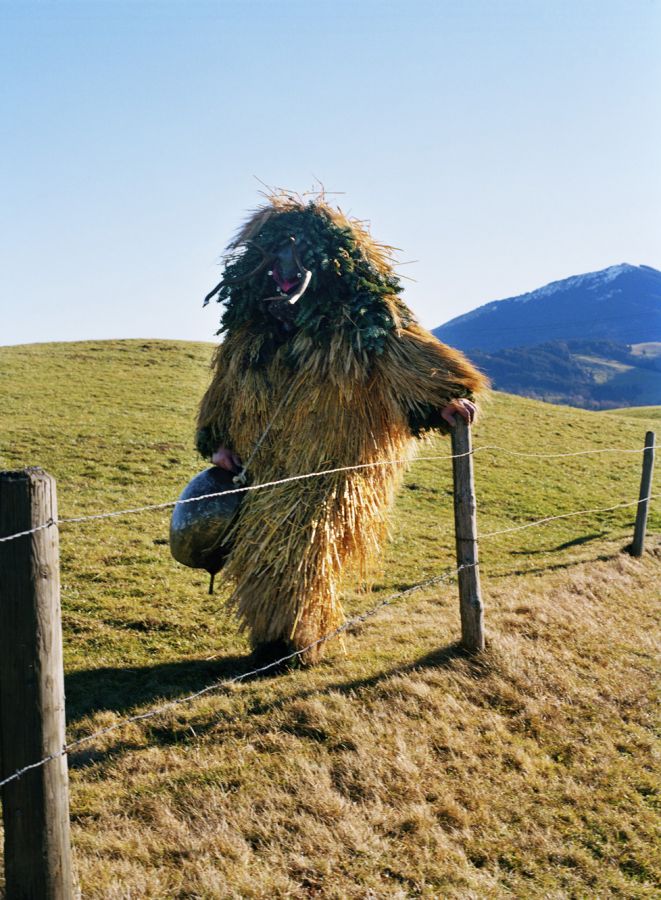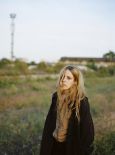What’s this curious apple tree?A fantastical representation
of a strange devotional object that I read about somewhere.
This object
is often called the “tree of souls”, and is part of a funerary
tradition. On a specific day, in Normandy or Brittany, a large branch is
chosen and apples are artificially pinned to it. The tree is then
placed in a chapel for a year, and the apples slowly rot there. The tree
can also be placed on graves on the Day of the Dead.
And that man in the field, with bells on his belt?This
is a character who escaped from a “procession” of others just like him
which roams the mountains of a Swiss village in Appenzell, twice a year,
as part of winter ritual traditions that take place all over Europe for
the winter solstice. His costume is made of shaggy straw, heavy, noisy
bells and a supposedly frightening papier-mâché mask. The group this man
belongs to is actually known as the “uglies”, as opposed to the group
of “beautifuls” who also roam the mountains in a less brutal and more
refined manner. Tradition has it that these groups go from farm to farm
and sing (they are great singers), ask for a drink, and ward off evil
spirits potentially lurking in every homestead. The origin of these
winter festivals dates back to the fear induced in peasant societies by
the onset of winter, associated with such evil spirits. Men would dress
up to try to defeat or communicate with evil spirits, and appease them
to ensure the spring would return and yield a plentiful harvest. This
particular fellow certainly looks slightly inebriated to say the least,
but posed proudly, at least for a few seconds.
Your images
often evoke traditions (Jewish communities in London, Japanese puppet
theatres) and manifestations of popular culture: what is the connection
between these different subjects? I find traditions as such
interesting for their theatricality and richness of details I perceive
as unusual, as someone who has never been part of any ritual group (with
a Communist mother, you’re not encouraged to attend church or join the
Boy Scouts or any type of brotherhood). Beyond the traditional, ritual
aspect of the events I photograph, what inspires me in all these
“communities” is their fascination for the “group”. How people can come
together and form powerful bonds, bonds that dictate certain principles
in their lives. Sometimes occasionally, as in winter traditions,
sometimes each and every day, as in London’s Orthodox Jewish community
for instance. The theatre also functions as a “troupe” – I’m thinking
here of the work I have been conducting on puppeteer and choreographer
Gisèle Vienne for several years now – where I’m attracted to this group
of people (dancers, actors, musicians and puppets) unconditionally bound
to each other. Not to mention the motifs that such groups form,
visually: order and chaos perpetually renewed.
Whether
through puppetry, masks, costume, or even tattoos, the body you depict
is often transformed: what is it that attracts you to these forms of
travesty and mutation? It’s true that the human body in all its
forms is a recurring theme in my work: disguised, naked, painted,
duplicated, imitated, inanimate… it’s an endless source of inspiration.
What attracts me is simply the universality of the body as a form, and
working with this “material” feels very natural. I have a twin sister,
and the older I get, the more I realize that my work around the body may
be connected to my twinship. Two relatively similar individuals growing
together, observing each other, two identities struggling to be
different, mutating over time, with different life experiences, but,
strangely enough, looking more like each other as time passes. Perhaps
this recursion of the body in my work is a kind of determined quest for
identity, for the unique and particular.
Limited edition, numbered and signed.

 A graduate of the Paris École des Beaux-Arts,
rewarded at the Hyères Festival in 2006, Estelle Hanania
initially discovered photography
in her school’s dark room,
where she produced large-format
colour prints. Following
an experience as
art director for
Ogilvy, she chose to
fully dedicate herself to photography. She quickly
combined personal work and
commissions for the
press, with her
own brand of poetic and pared-down style. Her images,
at times bathed in warm
light, at others shrouded in wintery blue,
oscillate between gentle
and harsh. Masks
and fancy dress are recurrent
motifs in her iconography - puppets
or men in the fields, they too
seeming to hesitate between affable
figures and unsettling
creatures.
A graduate of the Paris École des Beaux-Arts,
rewarded at the Hyères Festival in 2006, Estelle Hanania
initially discovered photography
in her school’s dark room,
where she produced large-format
colour prints. Following
an experience as
art director for
Ogilvy, she chose to
fully dedicate herself to photography. She quickly
combined personal work and
commissions for the
press, with her
own brand of poetic and pared-down style. Her images,
at times bathed in warm
light, at others shrouded in wintery blue,
oscillate between gentle
and harsh. Masks
and fancy dress are recurrent
motifs in her iconography - puppets
or men in the fields, they too
seeming to hesitate between affable
figures and unsettling
creatures. 